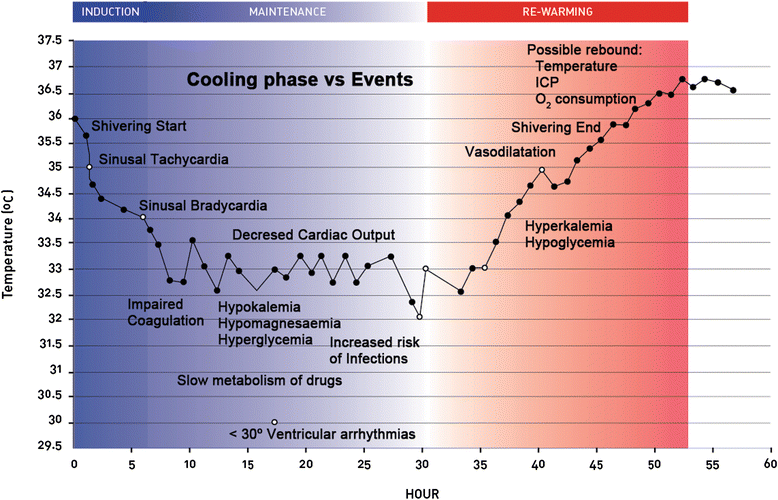Therapeutic hypothermia for acute brain injuries
- PMID: 26043908
- PMCID: PMC4456795
- DOI: 10.1186/s13049-015-0121-3
Therapeutic hypothermia for acute brain injuries
Abstract
Therapeutic hypothermia, recently termed target temperature management (TTM), is the cornerstone of neuroprotective strategy. Dating to the pioneer works of Fay, nearly 75 years of basic and clinical evidence support its therapeutic value. Although hypothermia decreases the metabolic rate to restore the supply and demand of O₂, it has other tissue-specific effects, such as decreasing excitotoxicity, limiting inflammation, preventing ATP depletion, reducing free radical production and also intracellular calcium overload to avoid apoptosis. Currently, mild hypothermia (33°C) has become a standard in post-resuscitative care and perinatal asphyxia. However, evidence indicates that hypothermia could be useful in neurologic injuries, such as stroke, subarachnoid hemorrhage and traumatic brain injury. In this review, we discuss the basic and clinical evidence supporting the use of TTM in critical care for acute brain injury that extends beyond care after cardiac arrest, such as for ischemic and hemorrhagic strokes, subarachnoid hemorrhage, and traumatic brain injury. We review the historical perspectives of TTM, provide an overview of the techniques and protocols and the pathophysiologic consequences of hypothermia. In addition, we include our experience of managing patients with acute brain injuries treated using endovascular hypothermia.
Figures
Similar articles
-
Clinical applications of targeted temperature management.Chest. 2014 Feb;145(2):386-393. doi: 10.1378/chest.12-3025. Chest. 2014. PMID: 24493510 Free PMC article. Review.
-
Hypothermia for acute brain injury--mechanisms and practical aspects.Nat Rev Neurol. 2012 Feb 28;8(4):214-22. doi: 10.1038/nrneurol.2012.21. Nat Rev Neurol. 2012. PMID: 22371279 Review.
-
Therapeutic hypothermia and targeted temperature management in traumatic brain injury: Clinical challenges for successful translation.Brain Res. 2016 Jun 1;1640(Pt A):94-103. doi: 10.1016/j.brainres.2015.12.034. Epub 2015 Dec 30. Brain Res. 2016. PMID: 26746342 Free PMC article. Review.
-
Clinical application of target temperature management in children with acute encephalopathy-A practical review.Biomed J. 2020 Jun;43(3):211-217. doi: 10.1016/j.bj.2019.12.003. Epub 2020 Jun 28. Biomed J. 2020. PMID: 32611538 Free PMC article. Review.
-
Therapeutic temperature modulation in severe or moderate traumatic brain injury: a propensity score analysis of data from the Nationwide Japan Neurotrauma Data Bank.J Neurosurg. 2016 Feb;124(2):527-37. doi: 10.3171/2015.3.JNS141895. Epub 2015 Sep 18. J Neurosurg. 2016. PMID: 26381247
Cited by
-
The Modulatory Role of Hypothermia in Poststroke Brain Inflammation: Mechanisms and Clinical Implications.Cerebrovasc Dis. 2024;53(6):776-788. doi: 10.1159/000536384. Epub 2024 Jan 29. Cerebrovasc Dis. 2024. PMID: 38286123 Free PMC article. Review.
-
High-quality targeted temperature management combined with decompressive craniectomy in patients with poor-grade aneurysmal subarachnoid hemorrhage: a secondary analysis of a multicenter prospective study.Front Neurol. 2025 Jan 6;15:1483037. doi: 10.3389/fneur.2024.1483037. eCollection 2024. Front Neurol. 2025. PMID: 39835158 Free PMC article.
-
Infusion of Cold Saline into the Carotid Artery Does Not Affect Outcome After Intrastriatal Hemorrhage.Ther Hypothermia Temp Manag. 2020 Sep;10(3):171-178. doi: 10.1089/ther.2020.0010. Epub 2020 May 22. Ther Hypothermia Temp Manag. 2020. PMID: 32456561 Free PMC article.
-
A peptide-neurotensin conjugate that crosses the blood-brain barrier induces pharmacological hypothermia associated with anticonvulsant, neuroprotective, and anti-inflammatory properties following status epilepticus in mice.Elife. 2025 Mar 28;13:RP100527. doi: 10.7554/eLife.100527. Elife. 2025. PMID: 40152901 Free PMC article.
-
Targeted Temperature Management for Patients with Acute Ischemic Stroke: A Literature Review.J Clin Med. 2024 Jan 19;13(2):586. doi: 10.3390/jcm13020586. J Clin Med. 2024. PMID: 38276093 Free PMC article. Review.
References
-
- FAY T. Observations on prolonged human refrigeration. N Y State J Med. 1940;40:1351–1354.
Publication types
MeSH terms
LinkOut - more resources
Full Text Sources
Other Literature Sources


